How to Eat a Mango, Yucatan-Style
One of the benefits of living in the tropics is the fresh tropical fruit that literally falls from the trees, and one of the most sought after, most delicious, most sensuous and altogether scrumptious fresh tropical fruits is the mango. Wikipedia claims that there are about 35 species of mangoes, and our experience shopping around for the last six years tells us that maybe five to eight species are sold and consumed here in the Yucatan.
Besides being one of the most delicious fruits on the planet, mangoes are also confounding to eat without making a complete mess of yourself and your surrounding area. Whenever we are lucky enough to eat breakfast at a tropical resort where slices of mangoes lie waiting, already carved from their cradle, we can never get enough. Sometimes, we are lucky to find mangoes on the street, prepared by vendors and served on a stick in a way we have no prayer of duplicating.
So, when called to taste of that sweet tasty flesh in the privacy of our own home or office, we are left to our own devices and we usually stand over the sink with mango juice running down our arms and off of our elbows, mouths smeared with pulp and juice. We invariably succeed in getting mango strings between all our teeth and leaving some of the delicious fruit uneaten as the big slippery seed eventually gets away from us.
And here we must confess that we have actually, in our anal-retentive stupor, when work or cleanliness has taken precedence over sensuality and bohemianism (you know how it is...), we have actually PASSED UP mangoes in the supermarket or let mangoes rot in our fruit dish at home rather than go through the trouble and mess of eating them.
The waste.
Well, we're here to tell you that that sad story will never be told in this family ever again!
Because today, we happened to walk into the office kitchenette while Joseph, our Yucatan-born friend and fellow Yucatan Living team member, was eating his own private mango. He was eating a yellow mango of the Ataulfo variety, one of our favorites (not just for its warm color and intense flavor, but for that seductive curve that graces one end of each fruit... a little cursive dollop that God just couldn't resist after She created this perfect food.). We watched in awe as Joseph deftly sliced, spooned and sucked that lovely innocent little fruit until it's naked seed lay on the plate, surrounded by what used to be its protective clothing. After getting over the shock of having watched a virgin mango being defruited right in front of us, we rushed to get the camera and try it ourselves.
Of course, such an important discovery could not go undocumented or unshared with our Yucatan Living community, so here, without fanfare but with joy in our hearts and just a few mango-threads between our teeth, we bring you Yucatan mango-eating instructions.
Hold the end of the mango that was previously attached to the tree towards you. With a sharp knife, slice into the fruit with the knife parallel to your body and cut straight down. Repeat on the other side. What you have now done is cut off the two 'rumps' or nalgas of the mango (is there any doubt that mango-eating is a sensuous experience?). The center part contains the semilla (seed). Start eating your mango by holding each plump little nalga in your hand, and spooning the mango out like you might a dish of ice cream or a half of an avocado. A ripe mango will just lay still and submissive as you spoon its tender flesh into your mouth with an ease we had not previously thought possible. After devouring the nalgas, pick up the half-naked semilla, peel off the skin on either side, and hold it at its base as you nibble the remaining flesh clinging to the large hard seed. (This part of eating a mango is sponsored by the Dental Floss Lobby.) When you have nibbled it from top to bottom, just toss it onto the plate...you are done!
Voila! A little mango between your teeth, perhaps a sticky finger or two... but nothing like the messy debacle of our (and undoubtedly YOUR) previous mango-eating experiences!
Joseph hastened to inform us that there is another popular way of eating a mango in these parts. There is a tool that can be purchased called a mango-fork. You just stick a mango-fork in the business end of a mango, cut a cross in the skin on the other end, peel the skin off like you would a banana, and indulge. And, oh look! There's a whole website devoted to mango-forks and a way to purchase them from someone in San Antonio, Texas who undoubtedly had a similar ah-ha! experience as we have had today (they also, for some reason, sell real estate and used auto parts, but we digress...).
We feel as if the world of mangoes has now opened up to us. The days ahead look brighter, a little yellowish-orange and a lot sweeter. We hadn't known how heavy the burden was that we were laboring under, avoiding the joy of mangoes, until we were liberated. Knowledge is freedom, and in this case, knowledge will definitely mean more mangoes. Spring is mango season here in the Yucatan, so we encourage you all to take this juicy nugget of information, go forth and eat mangoes!
>
That's all there is to it!
Now, go forth
and eat mangoes!




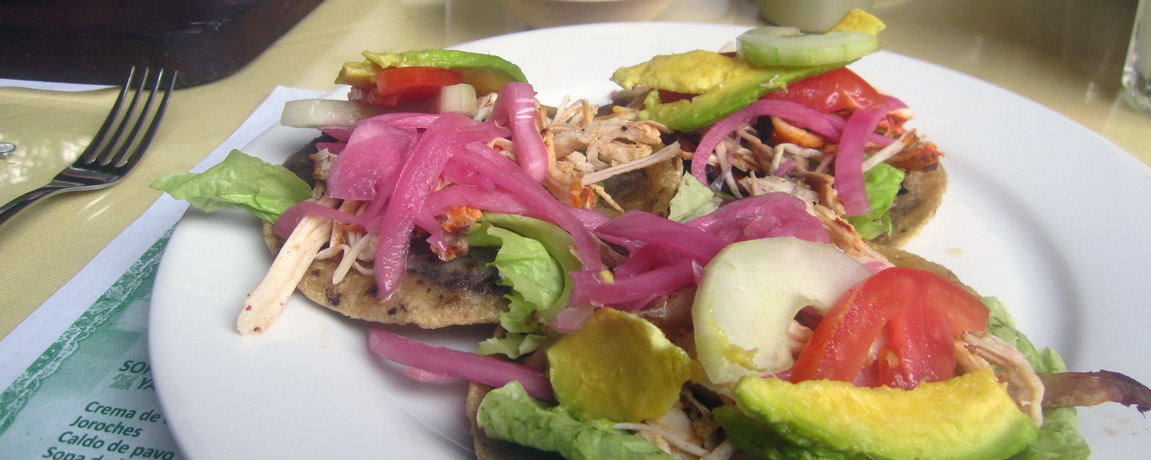



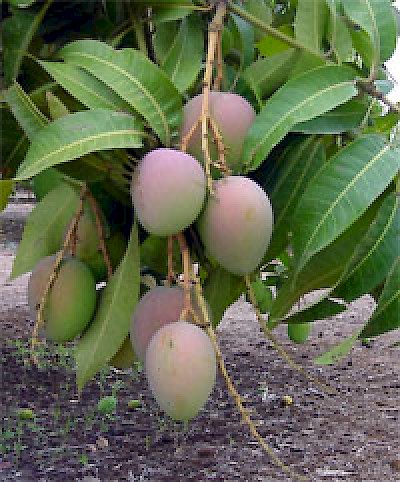
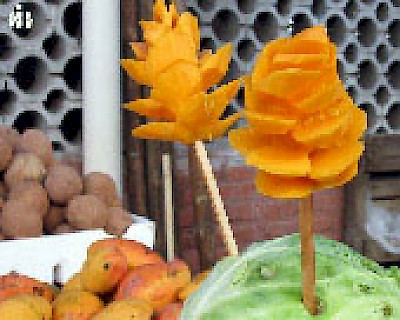
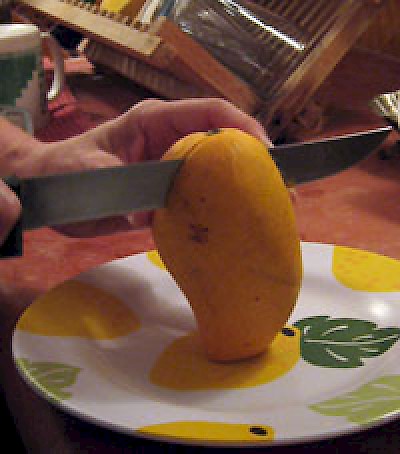
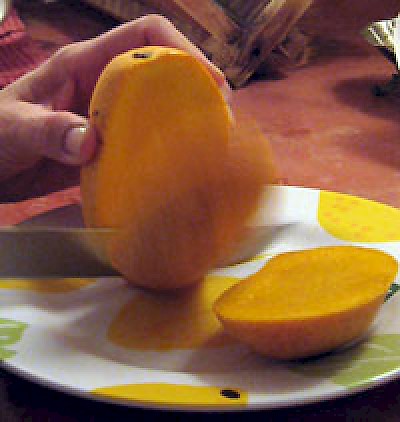
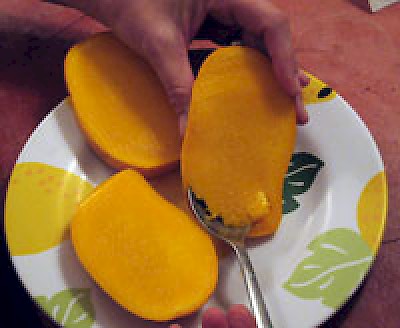
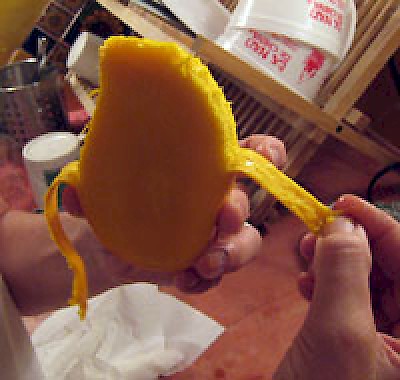
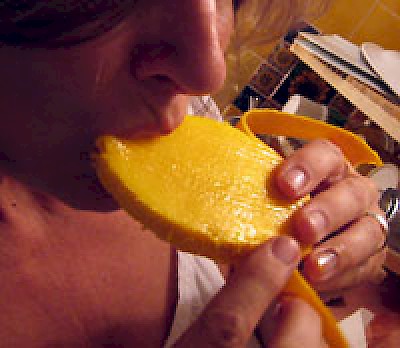
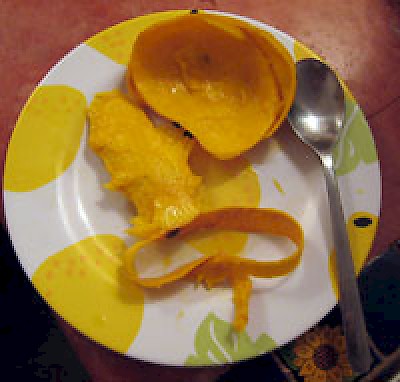

Comments
tusreba 17 years ago
I had my first mango this summer. I never knew how sweet and delicious they are.
I hope to be able to try some more someday.
Hope all is well with you and yours!
Mom
Reply
Rae Ann from Canada 17 years ago
We are heading off to Merida this summer and can't wait to try their wonderful Mangos with easier way to cut and eat them. Thank you so much for this artical, can't wait to make all kinds of wonderful recipes with Mangos. Does any one have a good one for Mango Moose dessert or any other recipes!?
Reply
Merissa 17 years ago
What a great tutorial! I remember practically living on mangos when I lived in Merida and this advice would have helped a lot back then. One of my other favorite things to do was buy a bag of very ripe mangos, slice them up into strips and throw them in the freezer. Whenever I needed a cool snack, these deliciously sweet, natural popsicles always did the trick.
Reply
Christine 17 years ago
I have been reading Mexico blogs all morning. You are the best and most entertaining writer. This was my first article. Now I am going to read them all. Hurrah. Christine
Reply
gabi 17 years ago
Once you are done with the cachetes or nalgas you can slice thin 'fillets' from around the seed which makes it a little less messy. I love mangoes and your article.
Reply
Maggie 17 years ago
Mmm. Delicious! Oh yes, informative, too.
Reply
Kim G. 17 years ago
There's another way to eat a mango that works well if it's not too juicy. Score the nalgas in a grid pattern to within a couple millimeters of the skin. Then you can sort of turn it inside out, and the scored bits will stick out like little cubes, which you can then either just nibble off, or cut off and into a bowl.
Regards,
Kim G
Boston, MA
Reply
Theresa in Merida 17 years ago
Henry, I once planted an entire mango that I let get overripe. After about 3 months, I decided to plant something else in that pot, imagine my surprise when i found that the mango had indeed sprouted! I had that seedling almost 2 years, it got about 3 feet tall when I realized that I didn't have space for a 30 foot tall mango tree in my yard. I gave it away, it didn't survive the transplanting though.
So the short answer is yes, you can plant a mango and get a tree. I don't know how long before it will bear fruit though.
regards,
Theresa
Reply
Henry 17 years ago
And the "semilla"? How do you plant that to bring these to your home?
Reply
MIKE 17 years ago
OXO company makes a very effective mango pitter. It creates two halves and the skin can be inverted with the fruit ready for knife, fork, or teeth.
Reply
Susi 17 years ago
Wonderful pictures! They are very self explanatory. I am from Mexico city, but I grew up in Chelem town. I´ve been here for the past 25 years and I and my family have always enjoyed mangos like this. Everybody should give it a try! I love your articles. Thanks. They are a lot of fun!
Reply
« Back (10 to 21 comments)Next »